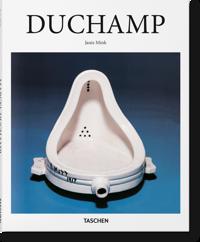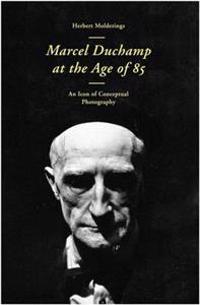Duchamp (Häftad)
avCalvin Tomkins
ISBN: 9780870708923 - UTGIVEN: 2014-06First published to great acclaim in 1996, "New Yorker" writer and art critic Calvin Tomkins' biography of the influential artist Marcel Duchamp (1887-1968) has been out of print for many years. Now, The Museum of Modern Art, New York, is publishing a new and revised edition of the landmark biography[...]
Duchamp Et Moi (häftad)
ISBN: 9780963740564 - UTGIVEN: 2014-02A tour-de-force of short fiction, dealing with subjects from jobs (held and hated as well as sought and fantasized about) to the varieties of affection, figuring among them the complexities of the family and those of relationships with men. She writes about dwelling places-apartments, buildings, and[...]
Marcel Duchamp and the Architecture of Desire (Häftad)
ISBN: 9781409443452 - UTGIVEN: 2013-12While much has been written on Marcel Duchamp - one of the twentieth century's most beguiling artists - the subject of his flirtation with architecture seems to have been largely overlooked. Yet, in the carefully arranged plans and sections organising the blueprint of desire in the Large Glass, his [...]
Fifty Shades of Alice Through the Looking Glass (Övrigt)
avDuchamp
ISBN: 9781469295800 - UTGIVEN: 2013-09FIFTY SHADES OF ALICE IN WONDERLAND WAS JUST THE BEGINNING... Eighteen-year-old Alice recently had an unprecedented erotic experience. But her adventures have only just begun to heat up. NOW SHE MUST TRAVEL THROUGH THE LOOKING GLASS... After breaking up with her boyfriend, Lewis, Alice enters a stra[...]
Five Works by Octavio Paz: Conjunctions and Disjunctions / Marcel Duchamp: Appearance Stripped Bare / The Monkey Grammarian / On Poets and Others (Inbunden)
avBritt Ulstrup Engelsen
ISBN: 9781611453119 - UTGIVEN: 201207One of the great thinkers of the twentieth century has some of his finest art, culture and literary criticism collected here for the first time. A Nobel laureate, Octavio Paz s lucid poetry has been translated by such luminaries as Mark Strand, Elizabeth Bishop, and Samuel Beckett, while his work as[...]
Marcel Duchamp
ISBN: 9781628723755 - UTGIVEN: 2014-08Octavio Paz claims in this essential work that the two painters who had the greatest influence on the twentieth century were Pablo Picasso and Marcel Duchamp. If that conjunction surprises at first, Paz makes a convincing case with his analysis and by contrasting the two artists. "I have linked thei[...]
Marcel Duchamp (Häftad)
avJulian Jason Haladyn
ISBN: 9781846380594 - UTGIVEN: 201002Following Marcel Duchamp's death in 1968, the Philadelphia Museum of Art stunned the art world by unveiling a project on which he had been working secretly for twenty years, long after he had supposedly given up art for chess. Installed by the museum curators with the assistance of Duchamp's widow T[...]
Marcel Duchamp
ISBN: 9781861892621 - UTGIVEN: 2006-04"Marcel Duchamp", by Paris-based curator and art critic Caroline Cros, is a new account of one of the most important cultural figures of modern times. Drawing on the artist's correspondence and interviews, she details Duchamp's life-long belief in chance and coincidence, and how that led him to let [...]
Marcel Duchamp (Inbunden)
avJennifer Gough-Cooper, Jacques Caumont, Andre (ILT) Raffray
ISBN: 9781900565158 - UTGIVEN: 1999-12A must for Duchamp devotees everywhere! This little introduction to the life and works of Marcel Duchamp was originally published to accompany a Duchamp retrospective at the Pompidou Centre in Paris. Modelled on a children?s book it contains 12 dead-pan full-page colour illustrations of events in D[...]
3 New York Dadas and the Blindman (Inbunden)
avMarcel Duchamp, Henri-Pierre Roche, Beatrice Wood
ISBN: 9781900565431 - UTGIVEN: 2012-03Dali/Duchamp
ISBN: 9781910350478 - UTGIVEN: 2017-11Eroticism, science and humor collide in the work of these two close friendsDali/Duchamp takes a detailed look at the little-explored relationship between two of the 20th century's most famous artists. The two might seem like polar opposites at first glance--Marcel Duchamp (1887-1968), the father of [...]
Aka Marcel Duchamp: Meditations on the Identities of an Artist (Inbunden)
avAnne Collins Goodyear, James W. McManus
ISBN: 9781935623151 - UTGIVEN: 2014-11"aka Marcel Duchamp" is an anthology of recent essays by leading scholars on Marcel Duchamp, arguably the most influential artist of the twentieth century. With scholarship addressing the full range of Duchamp's career, these papers examine how Duchamp's influence grew and impressed itself upon his [...]
Marcel Duchamp (häftad)
ISBN: 9783775743723 - UTGIVEN: 2017-12With The Great Hidden Inspirer, the fourth volume in the Poiesis series, Duchamp expert Michael R. Taylor, curator at the Philadelphia Museum of Art, investigates the role of Duchamp as the "secret mastermind" behind the decisive moments of 20th-century art history. Taylor reveals that it was Ducham[...]
Marcel Duchamp, 1887 - 1968 (Pocket)
avJanis Mink
ISBN: 9783822863169 - UTGIVEN: 2000-11An enigma to art historians and a great source of inspiration to other artists Someone else may have invented the wheel, but Marcel Duchamp (1887-1968) invented the ready-made. A bottle dryer may be a bottle dryer, but signed by Duchamp it is also one of the major works of 20th century art. Ducham[...]
Marcel Duchamp In Munich 1912
ISBN: 9783829605915 - UTGIVEN: 2012-06The iconoclastic creations of Marcel Duchamp (1887-1968) radically changed the 20th century art as well as our notion of it. Munich's role in this is worthy of note. Annoyed at the rejections of his painting Nude Descending a Staircase, No.2 by the Salon des Ind pendants, Duchamp traveled to Munich [...]
Marcel Duchamp
ISBN: 9783836534321 - UTGIVEN: 2016-12Readymade man Changing the course of 20th-century art When is a urinal no longer a urinal? When Marcel Duchamp (1887 1968) declared it to be art. The uproar that greeted the French artist s Fountain (1917), a porcelain urinal installed in a gallery, sent shock waves through the art world establishme[...]
Duchamp (Inbunden)
avJanis Mink
ISBN: 9783836543934 - UTGIVEN: 201306This title deals with art as anti-art. It is an enigma to art historians and a great source of inspiration to other artists. Someone else may have invented the wheel, but Marcel Duchamp (1887-1968) invented the ready-made. A bottle dryer may be a bottle dryer, but signed by Duchamp it is also one of[...]
Marcel Duchamp at the Age of 85 (Häftad)
ISBN: 9783863353322 - UTGIVEN: 2013-10In 1945, Marcel Duchamp published a photographic self-portrait in the American magazine "View" which depicted him--according to the caption--"at the age of 85." In reality he was, at the time, only 58 years old. In other words, the camera was being used as a "time machine," but not, as customary, to[...]
Marcel Duchamp
ISBN: 9783869843285 - UTGIVEN: 2013-04In this extended, illustrated essay, Swiss artist and author Stefan Banz (born 1961) describes Marcel Duchamp's discovery of the Forestay Waterfall near Chexbres, Switzerland, in the summer of 1946, and how it became the starting point for his famous final masterpiece, "Etant Donnes." Trilingual (Fr[...]
Meine Ehe mit Marcel Duchamp- Memoiren (Övrigt)
avLydie Fischer Sarazin-Levassor
ISBN: 9783905799071 - UTGIVEN: 2010-10



























